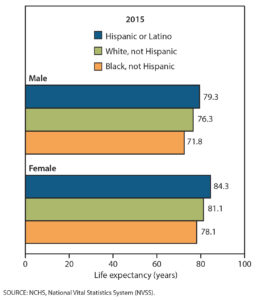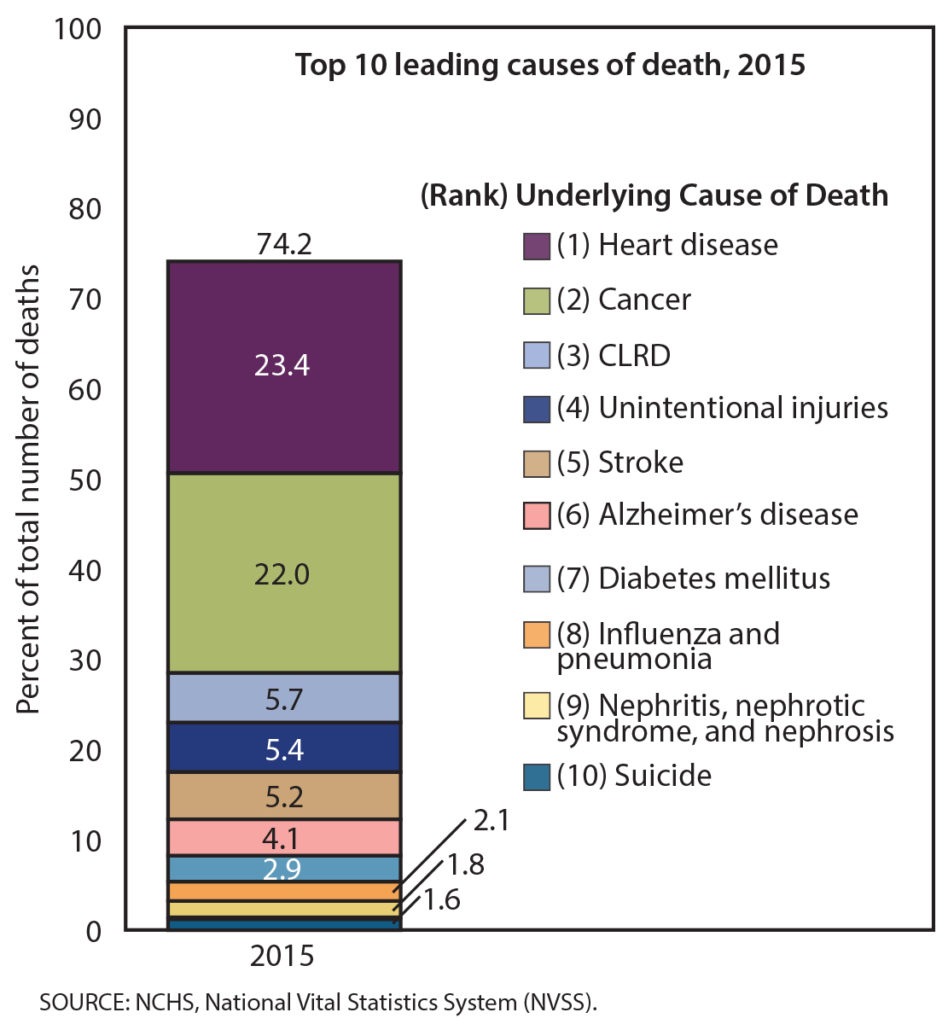Not bad, says CDC
Deaths from heart disease, cancer, chronic lower respiratory diseases, stroke and Alzheimer’s are down, but deaths from unintentional injury and suicide are up. The incidence of hypercholesterolemia, obesity and diabetes are up, but so is the percentage of Americans engaged in aerobic activity and muscle-strengthening. One more spot of good news: Cigarette smoking continues a downward trend.
Among the highlights of the Centers for Disease Control and Prevention’s 40th annual report on the health of the nation:
- Between 1975 and 2015, life expectancy increased for the total population. However, between 2014 and 2015, life expectancy declined by 0.1 years for the total population – 0.2 for males, and 0.1 for females.
- The infant mortality rate decreased 63 percent, from 16.07 to 5.90 deaths per 1,000 live births between 1975 and 2015.
- Heart disease and cancer remain the top two causes of death in the United States. However, between 1975 and 2015, the age-adjusted heart disease death rate decreased 61 percent, from 431.2 to 168.5 deaths per 100,000 population. The age-adjusted cancer death rate decreased 21 percent, from 200.1 to 158.5 deaths per 100,000 population.
- Between 1974 and 2015, the age-adjusted prevalence of current cigarette smoking declined from 36.9 percent to 15.6 percent among persons aged 25 and over.
- The age-adjusted percentage of adults aged 20 and over with obesity increased steadily, from 22.9 percent in 1988–1994 to 37.8 percent in 2013–2014.
- Prescription drug use increased for all age groups between 1988-94 and 2013-14. Among adults 65 and over, use of five or more prescription drugs in the past 30 days increased from 13.8 percent to 42.2 percent during the same period.
- The percentage of persons with an overnight hospital stay was lower in 2015 than in 1975 for males and females under age 75, but was not significantly different in 2015 than in 1975 for males and females aged 75 and over.
- Between 1975 and 2014, the number of community hospital beds per 1,000 resident population fell by almost one-half, from 4.6 to 2.5. The average length-of-stay per hospital stay fell by almost one-third, from 7.7 to 5.5 days, and occupancy rates declined almost 16 percent, from 75 percent to 62.8 percent.
Personal spending
Between 1975 and 2015, the share of personal health care expenditures paid for:
- Hospital care decreased from 45.3 percent to 38.1 percent.
- Physician and clinical services remained the same, at about one quarter (22.4 percent–23.4 percent).
- Nursing care facilities and continuing care retirement communities decreased, from 7.1 percent to 5.8 percent.
- Home health care increased from 0.5 percent to 3.3 percent.
- Dental services decreased from 7.1 percent to 4.3 percent;
- Prescription drugs increased from 7.1 percent to 11.9 percent;
- Other types of care increased from 10.6 percent to 13.2 percent.
Between 1978 and September 2016 (preliminary data), the percentage of children under age 18 who were uninsured decreased from 12 percent to 5 percent; the percentage with Medicaid coverage increased from 11.3 percent to 39.2 percent; and the percentage with private coverage decreased from 75.1 percent to 53.5 percent.
U.S. population changes
These trends in health and healthcare have occurred alongside changes in the demographic characteristics of the U.S. population:
- The U.S. population grew older between 1975 and 2015, as the number of Americans 65 and over increased from 22.6 million to 47.8 million.
- The U.S. population became more diverse. In 1980, 20.1 percent of the population were racial or ethnic minorities; by 2015, 38.4 percent of the population identified as racial or ethnic minorities.
- During 1975-2015, the percent of children under age 18 living in poverty reached a high of 22.7 percent in 1993, declined to 16.2 percent in 2000, rose to 22 percent in 2010, and then declined to 19.7 percent in 2015.
- The rural (nonmetropolitan) share of the population declined between 1970 and 2015; the suburban share of the population increased.
The full report – Health, United States, 2016 – is available at https://www.cdc.gov/nchs/hus/.

